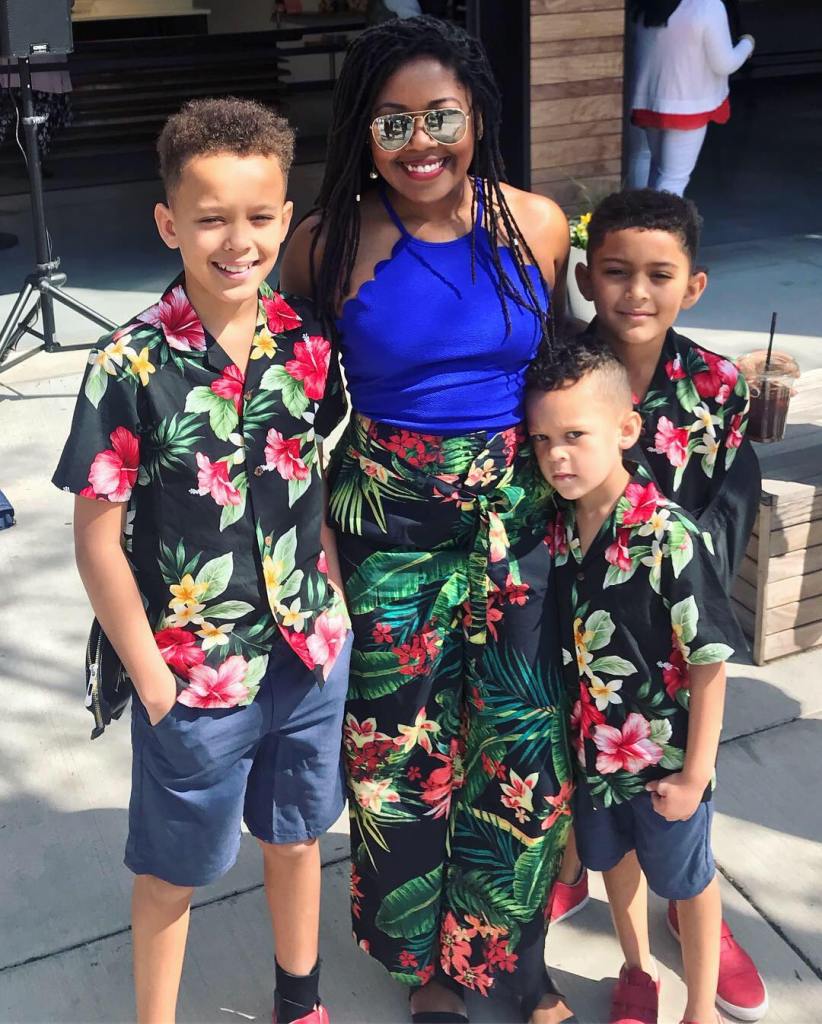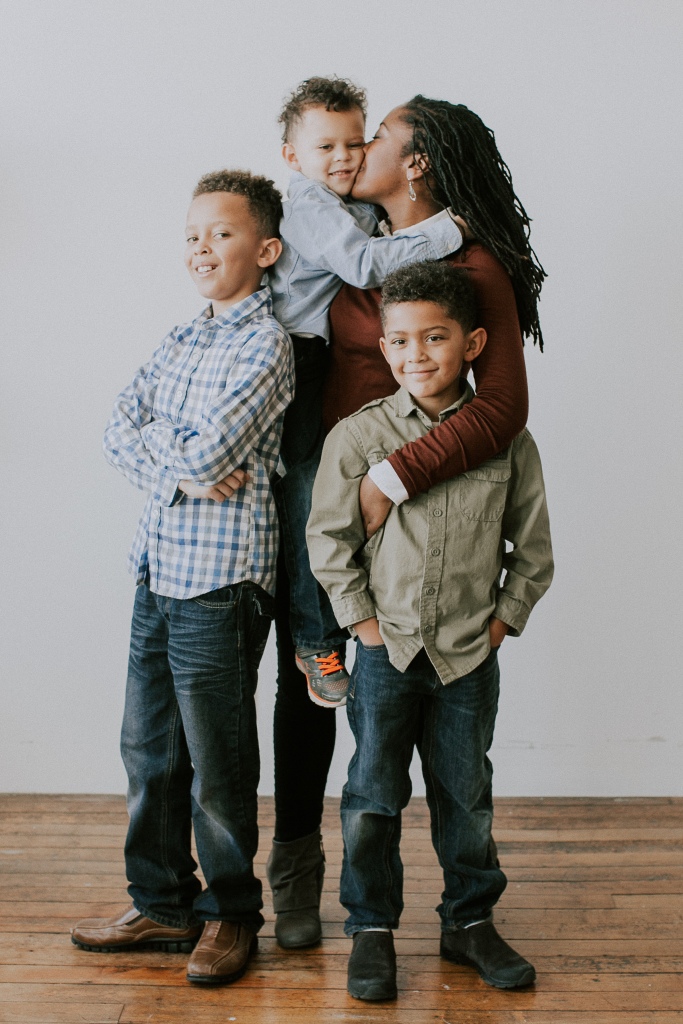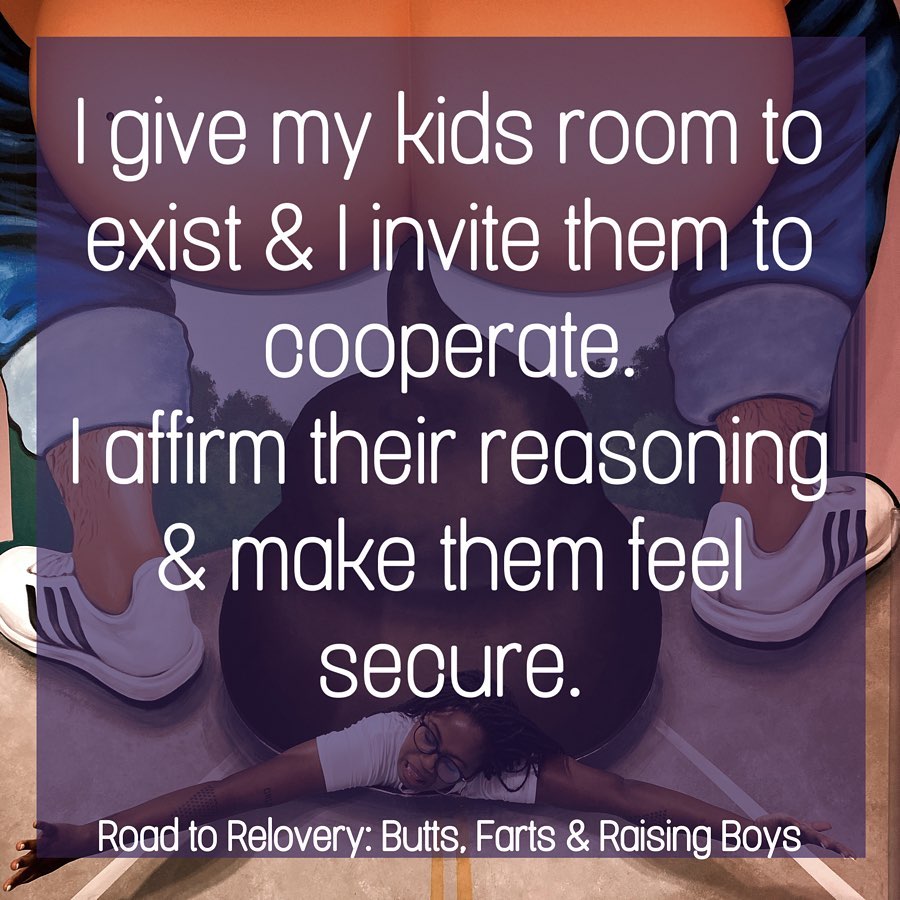Listen to this blog article as a podcast on Apple Podcasts, Spotify, or wherever you find your podcasts
The first thing people always say about my children is how beautiful they are – and its true! They’re adorable. My ex-husband is white, specifically Dutch and some stuff, and I’m black, specifically pan-African with a hint of western Europe and dash of South Asia, so our kids have an incredible presentation of genes. They each have different colors and textures of hair, and they each have a different eye-color, one green, one brown, one blue. And yes, all the same father, please don’t even go there with your judging mom-shaming purity-policing conditioning culture.
The first is PARENT. The verb. As in parenting.

After people tell me how handsome my kids are, they talk about how well-behaved, kind and cooperative they are. People always ask me what’s the secret! So here’s a quick list of some of the things I consistently do as a parent:
+PARENT
The first is PARENT. The verb. As in parenting. As in I am RAISING children to be secure, independent, members of society – I am responsible for sending thoughtful, compassionate, MEN into the world to thrive and find a place where their talents serve their community. I am shaping their behavior. I’m nurturing a tiny seed to have strong healthy roots, giving it what it needs to continue to flourish and provide for itself outside of my greenhouse.
I am RAISING children to be secure, independent, members of society – I am responsible for sending thoughtful, compassionate, MEN into the world to thrive and find a place where their talents serve their community. I am shaping their behavior.
+SHAPING BEHAVIOR
So what does shaping behavior look like? First of all, I have to talk about my pet peeves: tangled hangers. Answering questions with questions. Unnecessary defensiveness. Parents of ill-mannered children that blame it on kids being kids.
Here’s my disclaimer: DISCLAIMER: I’m focusing on your average well-child. I am not including children whose brains fit somewhere on the autism spectrum or any child diagnosed with another major developmental, neurological or psychological abnormality or delay. I’m talking about your generally mentally healthy child.
Ok, so parents of ill-mannered children that blame it on kids being kids is a pet peeve of mine. That’s why they have us – it’s our job to show and tell them how to behave and in what setting. Now it doesn’t mean that kids should be seen and not heard – it means we have to guide them, lovingly and attentively how to control their voices, their bodies and their emotions, and if that is beyond their control in that moment, that’s when you take them aside and give them space to scream, run, or have a total meltdown. It’s about CONTEXT – giving them space and security to be themselves, according to the context. We are parents – it’s our job to shape their behavior.
We’re in this together and we can have fun, but we need to all do our part if we’re going to make it through this adventure together.
If you don’t know this about me, I’m a big huge fan of using “I statements” and talking about my life – from my perspective. I try not to generalize or teach or dictate; I like to share – this is me and my story, this is what works for me. Leading up to this show, someone asked me, “Oh, are you talking about raising men from a man’s perspective or a woman’s?” And I said, “Um, neither. This is my experience and sharing what works for me.” I will never say women be like or men be like – I’m going to say, “Octavia be like…” and if it finds value in your heart, so be it. If it doesn’t, carry on.
So, in the realm of BEHAVIOR SHAPING, here’s what I do:
- Face-level instructions
- I get in their faces, at eye level either on my knees or all of us on chairs or a couch…and I explain what’s going on.
- Our home culture is like we’re a team and I’m the captain – we’re in this together and we can have fun, but we need to all do our part if we’re going to make it through this adventure together.
- I have only asked my kids to act like adults ONCE that I can remember, and I prepped them for it ahead of time. I told them I know they’ll think this [event] is boring, they’ll want to run around and scream and play, but just for 30 minutes, I need them to act like grown-ups, just in this setting, for this amount of time.
- It empowers them, sets up expectations and lets them know how long they need to put on a grown-up hat. I also think this empowers them to feel important in their own way, like they’re tasked with a really important, temporary, job.
- I avoid words like “obey” and “obedient” and instead I use words like “cooperate” and “participate.”
- I invite them to join me in doing this thing…
I avoid words like “obey” and “obedient” and instead I use words like “cooperate” and “participate.”
- Repetition – there are two kinds of repetition here
- The first connects to what I just mentioned – face-level instructions: I have the kids repeat what I said back to me, so I know they received the message I just sent in the way I meant for it to be received. We’re going to go to the store, you’re not going to ask me for Pokemon cards. What are you not going to do today? Ask for Pokemon cards.
- The second is I will never say anything only once. The sooner I realized that, the more rapidly my anxiety dropped. I will never say anything just once – TO THE SAME CHILD. Ryan, do you have your lunch? Yes. Ryan, do you have your lunch? Yes. Ryan, do you have your lunch? No. Ok, go get it. Ryan, go get your lunch.
- No is not a bad word. My children need to hear the word no, and understand that no has value. There doesn’t need to be a why or rationalization or negotiation. I said no.
- Give emphatic Yeses. I am hyper-conscious to give more yeses than I give nos. they’re both important and powerful words.
+Affirming Personalities & Unconditional Acceptance
Reminding my children that they have unique thoughts, opinions and decision-making skills and then affirming their judgement is a major factor in nurturing their autonomy and confidence. I use a ton of phrases like:
- Figure it out! – and then applaud them for what they figure out
- What do you think? – and then affirm their thoughts and let them lead if it really is a sound choice (Hey that’s a great idea! Let’s do that)
- Try it and see what happens – I love this one because it empowers them to take a risk and make adjustments if it failed, slowly desensitizing the fear of failure
- What do you like? – and then affirm their choices…
- PSA: THIS INCLUDES DEFYING GENDER ROLES – if my children want to paint their nails, play in wigs, makeup and skirts, or dresses (and sometimes they do), they can, with my emphatic support.
I put myself in timeout more than the kids.
+Planting Compassion
This one is kind of hard to do – because my boys don’t see a lot of masculine tenderness. There’s no male role model in my home and I have no idea what their dad does at his home – I only know how he was when we were married. So this is a tough one for me to teach, but here’s how I do it. If one of the boys is hurt, I model that compassion – even though I’m not a man, I hope some of the routine will stay with them.
- I first assess them like the first responder that is deep within me: Are you hurt? Tell me what happened.
- Then I acknowledge their pain. Wow that must have really made you feel bad – or that must have really hurt – or stung.
- Then I hold them. Do you want a hug? Ok.
- If the conflict is between each other, I’ll guide them through the process as peers: Look at your brother. How would you feel if the same thing happened to you? What would make you feel better? Why don’t you ask him how you can help him feel better? Ok, now do that thing, just like he asked.

+Growing Communication Skills
Ok, this touches on some of my pet peeves again: when people avoid, deflect or circumnavigate a direct question, answer a question with a question, or don’t ask the proper question needed to get the answers they need. Since these behaviors in adults bother the heck out of me, the only way I can fight this major evil is by training my children to not be those adults when they grow up. Hey – control what you can, right? This is hopefully just one part of a legacy of communication development that will be passed down for generations!
- Answering questions directly. Answer the question that was asked, not what you think the other person might actually be asking. This, I am guessing, is a learned behavior when you’re afraid of being in trouble, and/or constantly adapting to anticipate a passive aggressive person’s intent. In this case, I give them the opportunity to answer the question I asked. Here are some ways my children have recently responded to my questions:
- Where’s your phone?
- I wasn’t on it! // That’s not what I asked. // It’s on my bed.
- Did you finish all your schoolwork?
- My battery died. // That’s not what I asked. // No, but I will when my battery charges.
- Where’s your phone?
- Asking questions. When I teach my kids to ask questions, I teach them to first think about what they want to know, learn or gain from the question. Ask for what you want. Here are some examples:
- Are we going to target? // No. // Oh, I wanted a toy. // Then ask: Mom, I want to get a new toy; can we go to Target? // No. The answer is still No, but your end goal is the toy; not Target.
+Conflict Resolution
I don’t love being Referee Mom all the time, but when there is an actual disagreement (not just irritability and whining), I really get excited about this teaching moment. I have pulled a lot of these tips from watching Dr. Phil mediate circular arguments between toxic spouses and from watching Nanny 911/Super Nanny mitigating the most chaotic of households. I also get the role playing from my mom. Some of my best comebacks and bold statements I ever said as a kid were from my mom practicing an actual script with me at home.
- Stay in the present.
- Steve is always starting the game before I can log in! // What precisely just happened? I don’t want to hear about always or yesterday or last week – why are you upset now?
- Use I statements.
- Reminding the boys to tell me their own story helps turn down the blame and identify what part of the problem they can control themselves, ultimately helping them self-soothe.
- Role play.
- GIMME THAT CORD. // No, try again – Hey Ryan, my phone is dying, can I have the cord back I let you use? And then wait for his response.
- I’ll ask them to repeat the whole scene until they’re giggling and learning new language in healthy communication.
+Naming emotions
Emotions are meant to be felt. All emotions are good emotions. All emotions are for all people. I am always repeating this for the kids. I want them to crow into men that can feel, name those feelings without shame, express those feelings clearly without fear, and be present with other people’s emotions as well.
I’m highly intuitive and frequently feel a shift in my boys’ emotions before they even know how to use words to describe their feelings. I’m proactive in this way, but I still ask them to try and name what they’re feeling. I never try to cheer them up when they’re sad. I let them be sad. I make room for their feelings and invite them to take breaks until they feel differently.
Because children are young and learning, sometimes they don’t know what their feelings are called. They simply feel, without words. In this case, we have used a tool called SASHET (google it for some helpful graphics). SASHET stands for:
- Scared
- Angry
- Sad
- Happy
- Excited
- Tender
We’ll talk about what these words mean, and they can pick which one is closest to what they’re feeling. Then we take it from there, which usually includes either long cuddles or loud silliness.
I give them space to be funny, because, come on, farts are funny! But after the giggle, move on. If they can’t, that’s when I send them to the bathroom to spend quality time with their own butts and farts in privacy.
+POTTY TALK!
Here it is finally – I said we’d be talking about butts and farts.
They talk about butts and farts all day every day, any chance they get to say it, they say it. Penis. Weenis. Booty hole. Poops. Turds. All the things. All the smelly things.
I love bathroom humor as much as the next guy, but it is my job to tell them when the joke is old.
I give them space to be funny, because, come on, farts are funny! But after the giggle, move on. If they can’t, that’s when I send them to the bathroom to spend quality time with their own butts and farts in privacy.

+OWNING AND COMMUNICATING MY EMOTIONS as a parent
I put myself in timeout more than the kids – they know this!
Kids are kids and they’re gonna do kid stuff. And they’ll get loud. And messy. They’ll argue. They’ll break all your good shit. They’ll destroy things. They’ll lose things. They’ll exhaust the fuck out of you. And instead of losing my mind with them, I tell them:
Guys, I am tired. I’m getting frustrated because you’re not cooperating. I’m having a really difficult time. I’m going to go lay down and I don’t want to be interrupted. When I come back, let’s try this again, OK? OK.
And they know to leave me alone. They also know it’s not them – it’s not their fault – I’m not mad at them, I’m overwhelmed and tired. And I let them see I’m overwhelmed and tired. When I’m sad, I tell them I’m sad. If I need space I tell them I need space. When I want a hug, I ask for it. And they do the same.
So in conclusion…
- I give my kids room to be themselves
- I don’t police them – I let them make thought-based decisions
- I invite them to cooperate
- I affirm their reasoning and make sure they feel safe and secure
And so far… they’re the darlingest of darlings, and even better-behaved when I’m not around.
-OR

Leave a comment